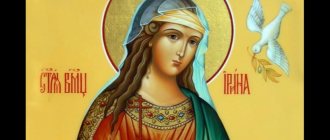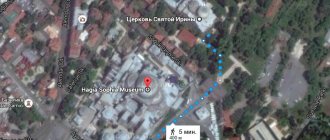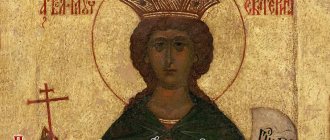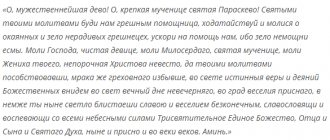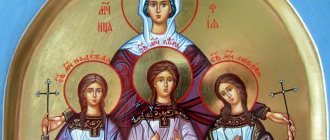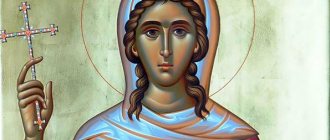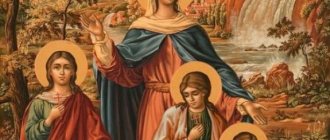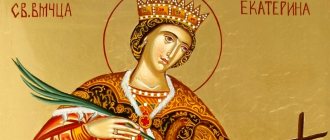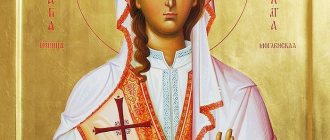The ruins of the Irininskaya Church were discovered in 1833. During the excavation of one of the ancient ramparts of Kyiv, a perfectly preserved foundation was discovered with the remains of a wall on it. These ruins, which were several centuries underground, by the nature of the architecture and the general appearance of the building material, clearly indicated the era in which this ancient structure should have arisen. And since, according to the chronicle legend, in this very place there was once a stone temple of the Holy Great Martyr Irene, built by Yaroslav the Wise, it was quite natural to assume that the ruins found were the remains of an ancient temple. When Vladimirskaya Street was laid in 1840, the ruins of the Irininskaya Church were demolished. Only one of the four pillars of the church’s foundation remained in place, as a memory of the ancient structure, which, unfortunately, has not survived to this day, as it was demolished in the 30s of the twentieth century during the anti-religious campaign.
Holy Martyr Irene of Constantinople
Saint Irene, along with her children and her husband, confessor George, suffered for the veneration of holy icons in Constantinople in the first half of the 9th century.
Emperor Theophilus forced them to renounce the worship of holy icons, but the courageous confessor George and his wife refused to fulfill the command, declaring to the wicked emperor that by worshiping the holy icons, we worship their Eternal Prototype. For disobedience, the emperor ordered the property of St. George's family to be taken away and plundered, and he himself, with a rope around his neck, to be dragged through the streets of Constantinople and thrown into prison.
Afterwards the family was sent into exile.
The memory of the holy confessors is celebrated on May 13/26.
How does the Great Martyr help?
Orthodox Christians of many generations come to the Holy Great Martyr Irina with requests. They turn to her to solve problems:
- in family life;
- with health;
- when faith weakens;
- and also about overcoming doubts and gaining confidence;
- about destroying the machinations of enemies and ill-wishers and getting a job.
It is believed that Irina the Great is the patron of missionaries, preachers, and people who study the Word of God. The saint also provides special protection to girls who bear her name.
Reverend Empress Irina-Piroshka
Born in 1088 in Esztergom in the family of King Ladislaus I of Hungary and Adelaide of Swabia. Already in 1090 she lost her mother, and in 1095 her father also died. The Hungarian throne was succeeded by Koloman, nephew of King Ladislaus I, as guardian of the orphaned princess.
In an effort to improve relations with the Byzantine Empire, Koloman married Piroshka to the son of the reigning Emperor Alexios I Komnenos, John. The latter had already been co-ruler since 1092 and was the heir to the royal throne. Despite the princess's reluctance, the wedding took place in 1104. Along with her marriage, the Hungarian princess converted to Orthodoxy and was named Irina.
Settling at the court in Constantinople, Irene led a quiet and pious life, not interfering in politics even after her husband became emperor in 1118. The queen devoted a lot of time to raising her eight children. She did not turn away from those in need and took care of Hungarian pilgrims to the Holy Land. Together with Emperor John, she founded the temple and monastery of the Savior Pantocrator in Constantinople.
At the end of her life, the pious empress took monastic vows with the name Xenia. Her death followed on August 13, 1134. The body of the Reverend Empress Irina-Xenia was buried in the Monastery of the Almighty, which she founded.
Her memory takes place on August 13, the day of her death.
Children
Fyodor Ioannovich and Irina Godunova did not leave any heirs. There were rumors about the tsar's poor health, even foreign doctors were prescribed, but it was all in vain. Their only daughter, Theodosia, born in May 1592, did not live even two years. Queen Irina was pregnant several times, but she was never able to give the Tsar an heir. Centuries will pass until it becomes known that she had a special pelvic structure that precluded normal childbearing.
On his deathbed, Ivan the Terrible bequeathed to his son to marry Irina Mstislavskaya if his current wife turned out to be childless. He understood well that without an heir in the country, a time of unrest and chaos would soon come, destructive for Russia. Queen Irina realized the precariousness of her position. Her older brother Boris came to the rescue: Mstislavskaya was kidnapped from her parents' home and tonsured as a nun against her will.
Martyrs Agapia, Irene and Chionia of Aquileia
The holy martyrs Agapia, Irene and Chionia were sisters and lived at the end of the 3rd - beginning of the 4th century near the Italian city of Aquileia. They were left orphans at a young age. The girls led pious Christian lives and rejected the advances of numerous suitors. Their spiritual leader was priest Zinon. It was revealed to him in a dream vision that he would soon die, and the holy virgins would be taken to be tortured. The same revelation occurred to the Great Martyr Anastasia († c. 304, commemorated December 22/January 4), who was in Aquileia, who was called the Pattern Maker because she fearlessly visited Christians in prison, encouraged them and helped them. Great Martyr Anastasia hurried to the sisters and urged them to courageously stand up for Christ. Soon what was predicted in the vision came true. The priest Zenon died, and the three virgins were captured and sent to trial before the emperor Diocletian (284–305).
Seeing the young beautiful sisters, the emperor invited them to renounce Christ and promised to find noble suitors from his retinue. But the holy sisters answered that they had one Heavenly Bridegroom - Christ, for whose faith they were ready to suffer. The emperor urged them to renounce Christ, but neither the older sisters nor the youngest of them agreed. They called the pagan gods idols made by human hands and preached faith in the True God.
By order of Diocletian, who went to Macedonia, the holy sisters were also taken there. They were handed over to the ruler Dulcytius for trial.
When he saw the beauty of the holy martyrs, he was inflamed with unclean passion. He took the sisters into custody and told them that they would receive freedom if they agreed to fulfill his wish. But the holy martyrs replied that they were ready to die for their Heavenly Bridegroom - Christ. Then Dulcitius decided to secretly take possession of them by force at night. When the holy sisters got up at night to pray and praised the Lord, Dulcytius crept to the door and wanted to enter. An invisible force struck him, he lost his mind and rushed away. Finding no way out, the tormentor on the way ended up in a kitchen where there were cast irons, frying pans and cauldrons, and became all dirty with soot. Servants and warriors hardly recognized him. When he saw himself in the mirror, he thought that the holy martyrs had bewitched him, and decided to take revenge on them.
At the trial, Dulcitius ordered the holy martyrs to be naked before him. But the soldiers, no matter how hard they tried, could not do this: the clothes seemed to have grown to the bodies of the holy virgins. During the trial, Dulcitius suddenly fell asleep and no one could wake him up. But as soon as they brought him into the house, he immediately woke up.
When Emperor Diocletian was informed about everything that had happened, he became angry with Dulcetius and handed the holy virgins over to judge Sisinius. Then he began his interrogation with his younger sister Irina. Convinced of her inflexibility, he sent her to prison and tried to force the saints Chionia and Agapia to renounce. But it was impossible to persuade them to renounce Christ, and Sisinius ordered the burning of saints Agapia and Chionia. The sisters, having heard the verdict, thanked the Lord for the crowns of martyrdom. In the fire, Agapia and Chionia went to the Lord in prayer.
When the fire went out, everyone saw that the bodies of the martyrs and their clothes were not scorched by fire, and their faces were beautiful and calm, like those of people who had fallen asleep in a quiet sleep. The next day, Sisinius ordered Saint Irene to be brought to trial. He frightened her with the fate of her older sisters and persuaded her to renounce Christ, and then began to threaten to hand her over to be mocked in a whorehouse. But the holy martyr answered: “Let my body be given over to violent desecration, but my soul will not be desecrated by renouncing Christ.”
When the warriors of Sisinius led Saint Irene to the fornication, they were overtaken by two bright warriors and said: “Your master Sisinius commands you to bring the girl to a high mountain and leave there, and then come to him and report on the fulfillment of the order.” The warriors did just that. When they reported this to Sisinius, he became furious because he had not given such an order. The bright warriors were Angels of God who saved the holy martyr from desecration. Sisinius with a detachment of soldiers headed towards the mountain and saw Saint Irene on its top. For a long time he searched for the way to the top, but could not find it. Then one of the warriors wounded Saint Irene with an arrow from a bow. The martyr shouted to Sisinius: “I laugh at your powerless malice and go clean, undefiled to my Lord Jesus Christ.” Having thanked the Lord, she lay down on the ground and gave up her spirit to God the day before Holy Easter († 304).
Irina's birthplace was Athens. For her extraordinary beauty, Emperor Constantine V chose her as a wife for his son Leo. After the death of her father-in-law and the accession of Leo IV to the throne, Irina began to almost openly patronize icon worshipers. Her royal husband turned a blind eye to this for some time, but when in the summer of 780 two icons were discovered in the empress’s bedroom, he became so angry that he drove her out of the palace. But in the same year he died, and Irina became regent for her ten-year-old son Constantine VI, and in fact, the sovereign ruler of the empire. Forty days after the death of Leo, some of the first officials formed a council to make Caesar, Nicephorus, his brother, emperor. This intention was revealed. Irina ordered to seize all the conspirators, flog them, cut their hair and send them to prison in different countries. She tonsured her Shuryevs, the Caesars and the Most Serene, into the priesthood and ordered them to serve before the army on the day of the Nativity of Christ. In 781, the Sicilian strategist Elpidius rebelled and declared himself emperor, but he was soon defeated and fled to Africa.
Having established herself in power, Irina gradually began to work towards restoring the veneration of icons. In 784, the iconoclast patriarch Paul took monastic vows and died (Before his death, he bitterly complained about his weakness and the fact that, under pressure from the emperor, he was forced to show himself an enemy of icons). After the death of Paul, everyone began to boldly rebel against the iconoclasts. By the will of the empress, Tarasius was appointed patriarch, who immediately began to work for the convening of an Ecumenical Council. In the summer of 786, many bishops came to Constantinople, they gathered in the Church of the Holy Apostles, began to read the holy scriptures and compare dubious passages, while the empress remained a spectator among the catechumens. Suddenly, in the midst of the meeting, soldiers burst into the temple and, threatening with swords, forced the bishops to disperse. They did not listen to the empress, who tried to calm them down. The following year, Irina pretended to want to defend the eastern borders from Arab attack. The army and retinue set out on a campaign and reached Malaginov. At this time, Irina brought Thracian units into the capital. To those who came out, she sent an order to return the weapons to the treasury, since it no longer needed them. The warriors had no choice but to fulfill her will. Then they were sent with their families, each to their own city, and Irina formed a new army, put at its head loyal commanders and in May sent out invitations to the council, appointing Nicaea as its venue. The Seventh Ecumenical Council opened in September 787. It did not add anything new and kept the decisions of previous councils intact, but rejected the iconoclastic heresy.
Irina spent the following years in a stubborn struggle for power with her son. In 790, she tried to remove him from the throne and forced the troops to swear that as long as she lived they would not allow her son to reign. However, the Armenian Legion refused to take such an oath. Fearing the riot of the soldiers, Irina eventually released Constantine to them, who was proclaimed sovereign emperor. Constantine expelled all her eunuchs, and imprisoned the empress herself with full security in her palace Eleferia, built by her, in which she managed to hide most of the treasury. With the help of this money, Irina began a complex intrigue against her son. In 796, the emperor and his mother went to Prusia to warm waters. Then Konstantin learned about the birth of his son Leo, left Irina on the waters along with his entire retinue and officials, and he himself returned to the city on a fast ship. Taking advantage of this opportunity, Irina spoke with the leaders of the legions, persuaded them with gifts and promises to depose her son and recognize her as the sole ruler of the empire; She cajoled some herself, others through her associates, and brought everyone to her side. Betrayed by everyone, Constantine was deposed in 797 and blinded.
With the return of Irina, the affairs of government were concentrated in the hands of her two eunuchs - Stavricius and Aetius, who were at enmity and weaved many intrigues against each other and all possible contenders for power. In 800, Irina ordered all the brothers of her late husband to be blinded. Finally, in 801, after the death of Stauricius, Aetius took all power and acquired enormous strength. But, despite all his resourcefulness, he overlooked the conspiracy that had developed against him. In 802, the logothete Nikephoros deposed Irene, exiled her to the island of Prinkipo, then transferred her to Lesbos and ordered her to be kept under cruel guard. Not surviving her fall, the empress died very soon.
Ingegerda, in Holy Baptism Irina (Blessed Princess Anna of Novgorod)
Ingegerda (1001 - February 10, 1050) - the eldest daughter of King Olaf Skötkonung of Sweden (994-1022), nicknamed "the most Christian king", and Estrid (Astrid) - was born in Sigtuna in Sweden. In 1008, the king, his family and squad received holy Baptism. Ingigerda received an education that was exceptional for a woman of that time: she studied the Holy Scriptures, literature, and history. She was a true daughter of Scandinavia of the Viking Age and therefore from an early age she enjoyed great freedom, participated in the public life of her homeland, traveled, received guests, and was good with weapons. Historical sources especially note her intelligence, courage, and great influence on others.
You can't stop living beautifully
The outfits of the sovereign's wife were distinguished by sophistication and luxury. Arseny Elassonsky, the archbishop present at Irina Godunova’s reception, describes her attire this way: “The slightest part of this splendor would be enough to adorn a dozen kings.” The empress's crown was decorated with deep purple amethysts and large sapphires. The main hall, later called the Golden Chamber, was skillfully painted in gold and decorated with frescoes depicting the lives of great female rulers: Princess Olga, Saint Helena, Queen Dinara. These chambers became the reception area for many Russian monarchs.
Nun Alexandra
Queen Irina, freed from the burden of rule, lived within the walls of the monastery for about 5 years. Severe ascetic conditions, a damp, cold cell and meager food did not benefit the not yet old woman.
According to studies of her sarcophagus, nun Alexandra had diseased joints and hereditary pathology of bone tissue. She probably had difficulty moving in recent years. This is also evidenced by the increased content of lead, mercury, and arsenic in her remains. Apparently, the former queen often practiced treatment with ointments in order to somehow relieve the pain.
